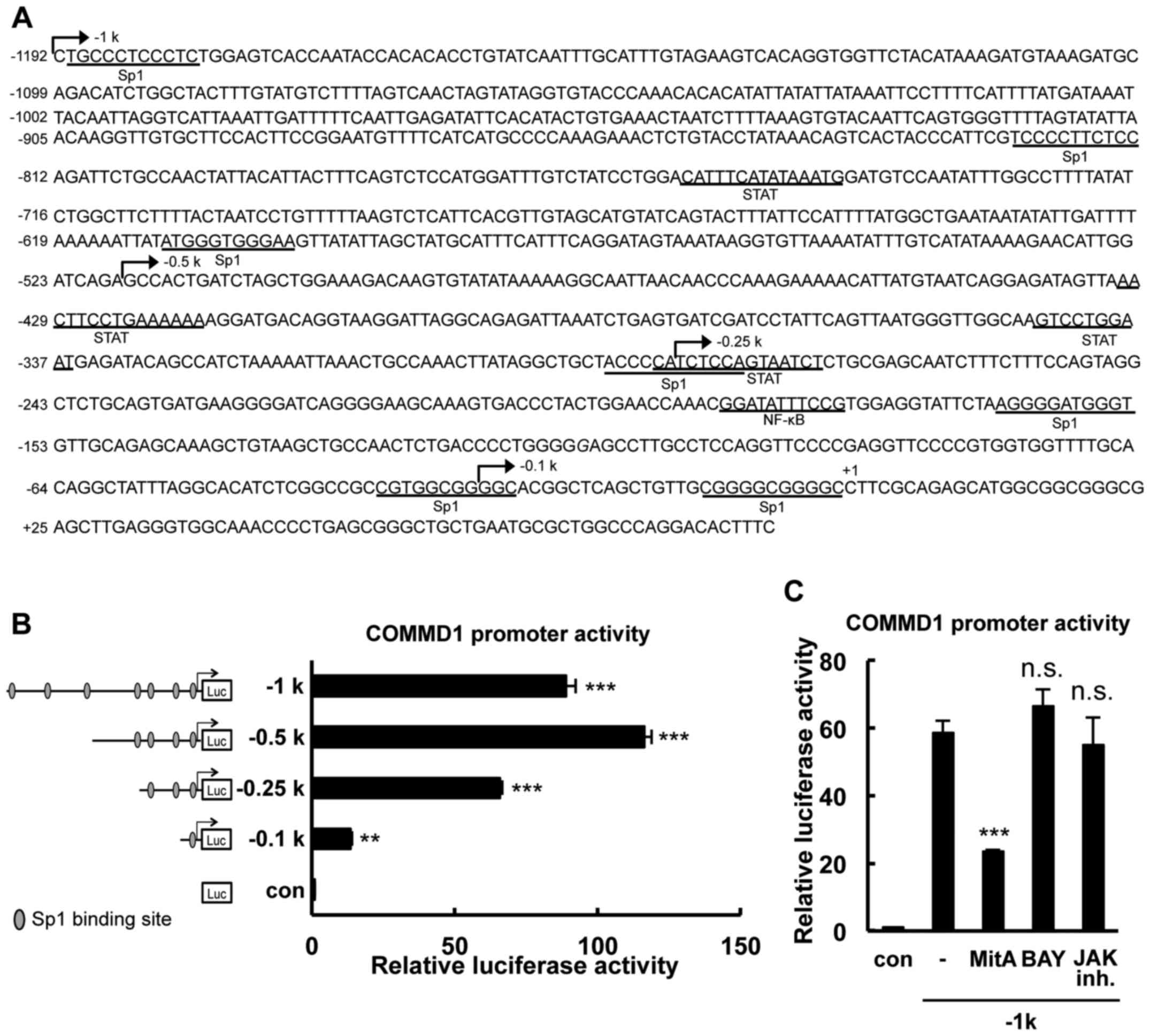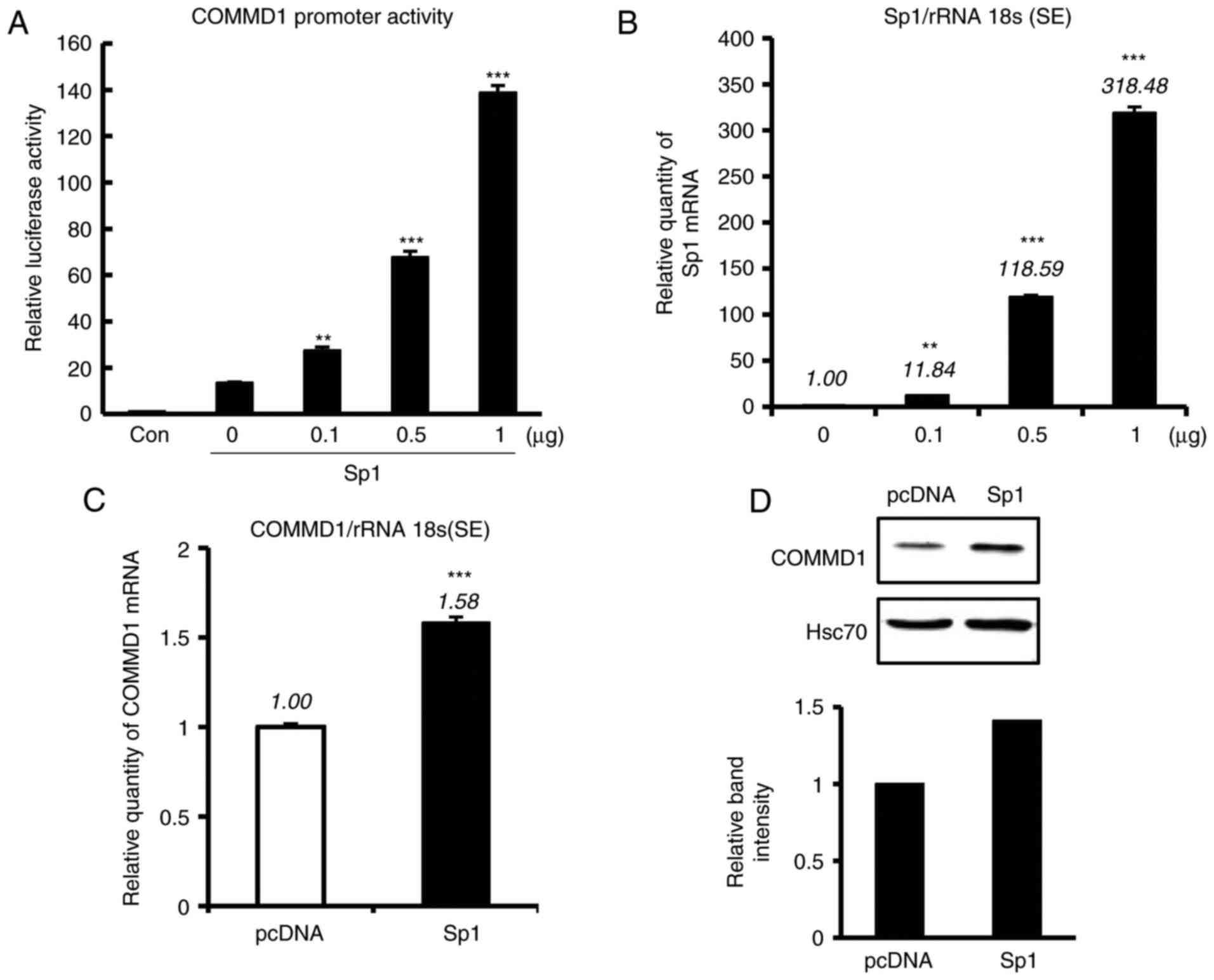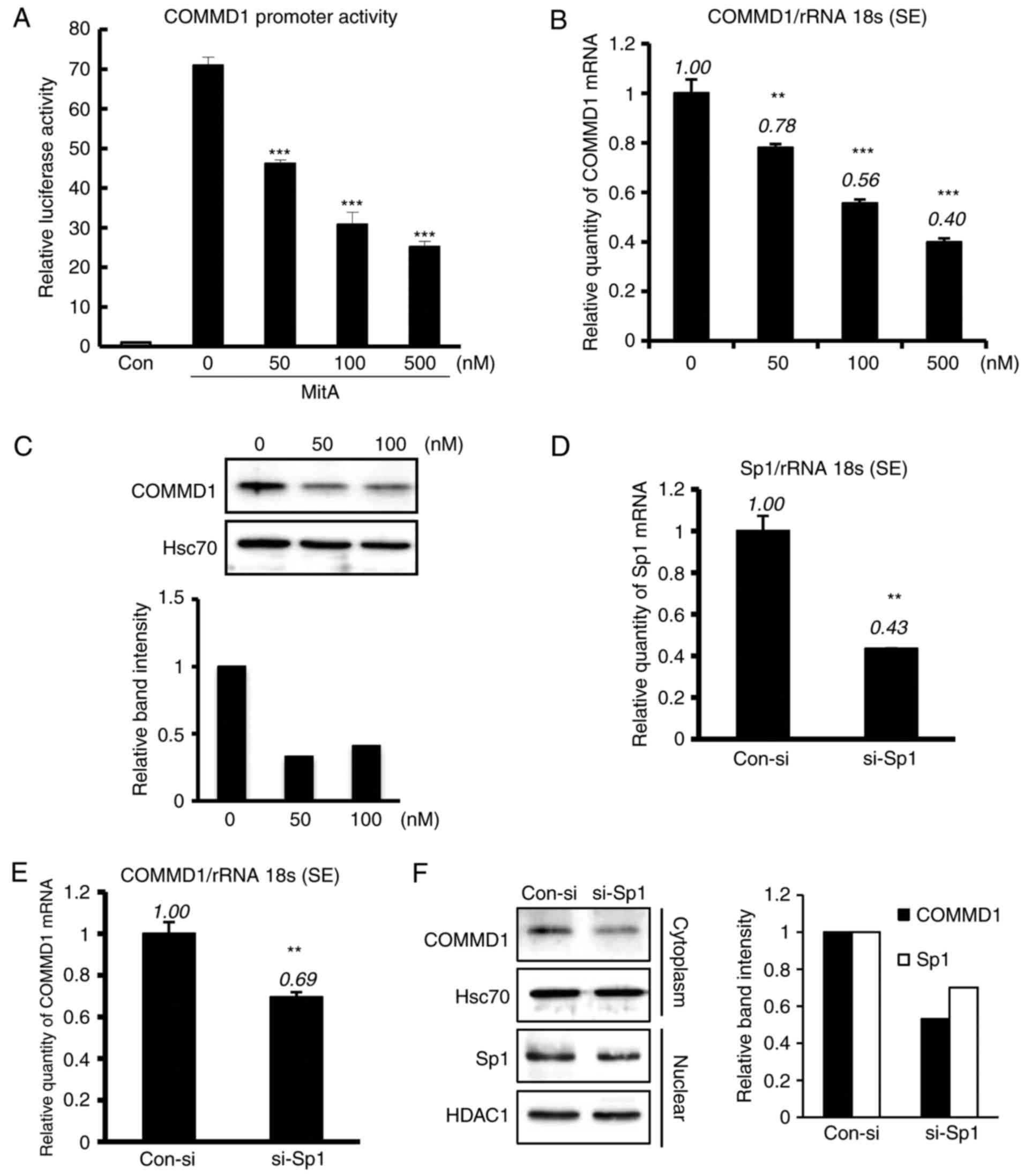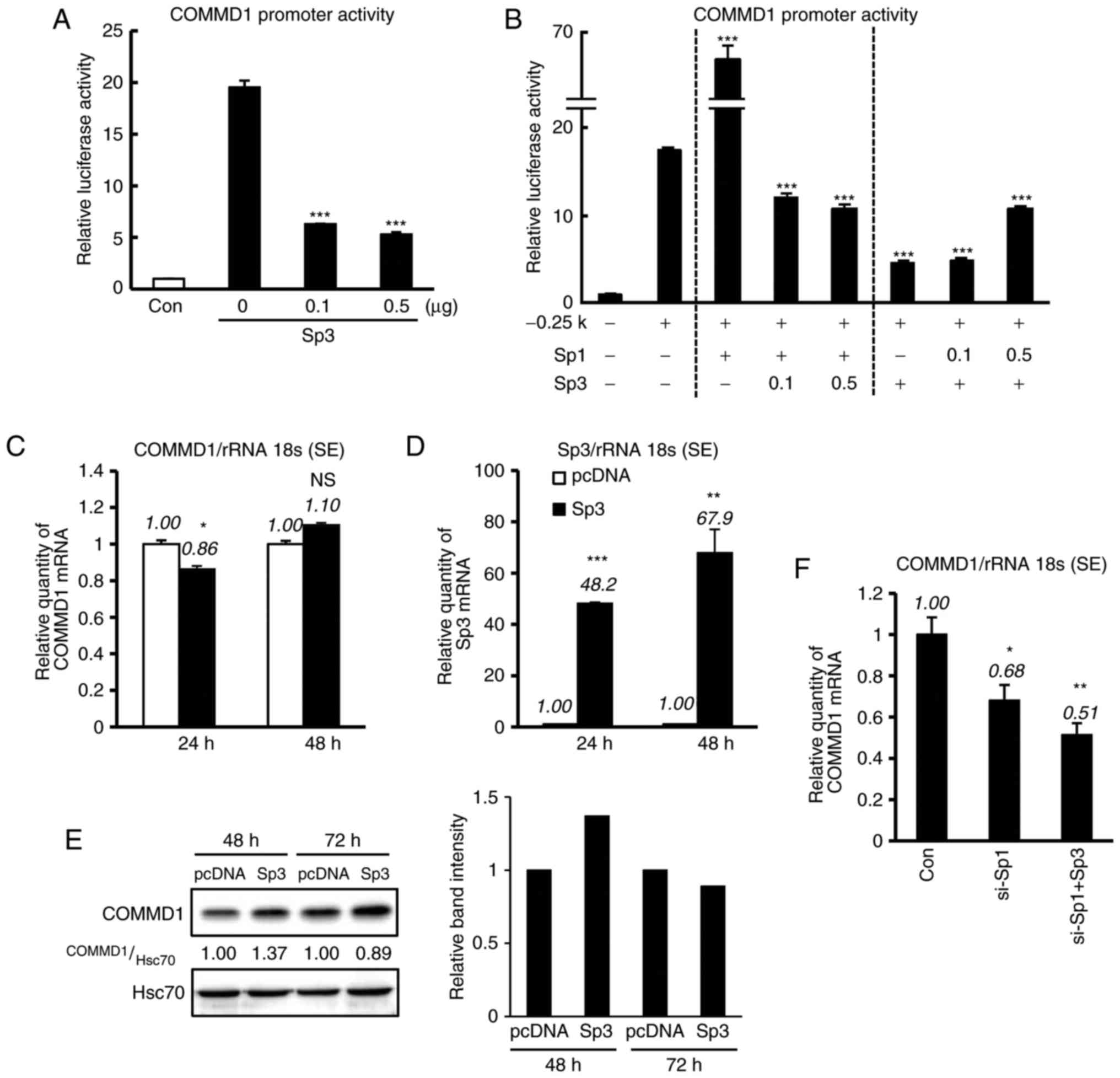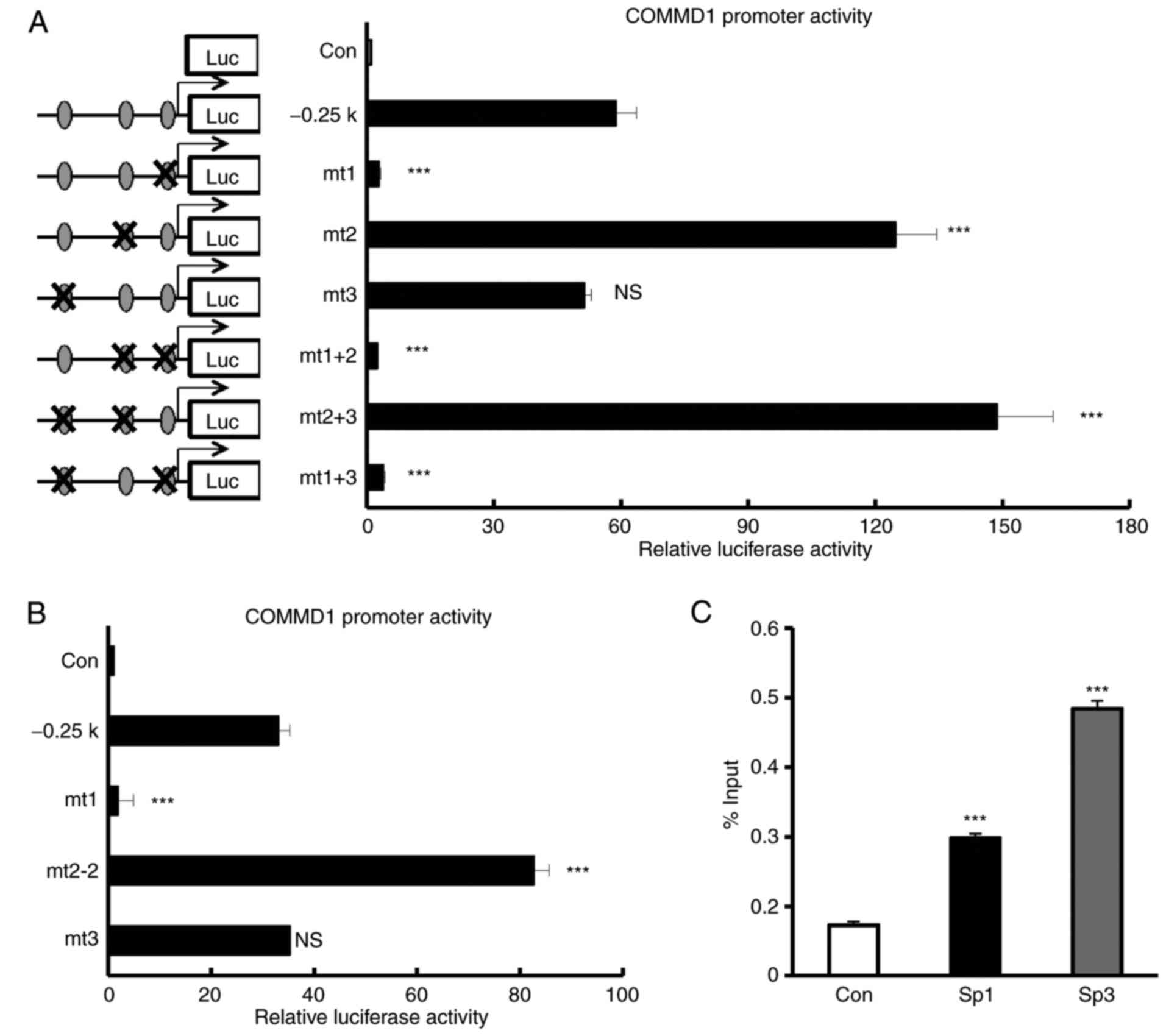Transcriptional regulation of HIV-1 host factor COMMD1 by the Sp family
- Authors:
- Published online on: January 15, 2018 https://doi.org/10.3892/ijmm.2018.3386
- Pages: 2366-2374
Abstract
Introduction
Copper metabolism Murr1 domain containing 1 (COMMD1) is a member of the COMMD family, which has ten members. This protein family is distinguished by a unique C-terminal motif called the COMM domain (1,2). COMMD1 was previously reported to regulate copper homeostasis by binding to ATPase copper transporting alpha/beta (ATP7A/B), which are associated with the copper storage disorders Menkes disease and Wilson's disease (3,4). COMMD1 regulates the folding, stability, ubiquitination and protein degradation of its interaction partner proteins, including ATP7A, ATP7B and nuclear factor (NF)-κB (5–8). COMMD1 has been reported as a human immunodeficiency virus (HIV)-1 host factor and inhibits HIV-1 replication by blocking the degradation of the inhibitor of NF-κB (IκB-α) (9). A previous study by our group reported that IκB-α expression is increased by HIV-1 latent infection through the induction of COMMD1 expression. Induction of COMMD1 in HIV-1 latent-infected cells also maintains latent HIV-1 infection. The expression of the COMMD1 protein and mRNA in HIV-1 latent-infected myeloid cells is stronger than in parental cells (10). However, it remains elusive how COMMD1 transcription and expression are regulated. To the best of our knowledge, no previous studies have assessed COMMD1 transcriptional regulation.
The transcription factors specificity protein 1 (Sp1) and Sp3 belong to the Sp family, which has four members. Sp factors bind to GC-rich DNA sequences in human gene promoters. The Sp family is ubiquitously expressed and regulates a number of housekeeping and tissues-specific genes (11,12). Sp1 and Sp3 have 90% DNA sequence homology in the zinc finger-binding domain and exhibit similar specificities and affinities for DNA binding (13). However, although there are structural similarities between them, a functional comparison identified Sp1 as a transcriptional activator, with Sp3 being either a gene expression activator or repressor depending on the promoter structure or cell type (13,14).
The present study hypothesized that basal COMMD1 transcription is regulated by Sp1 because COMMD1 expression is ubiquitous (1), and due to prospective consensus Sp binding sites identified in the human COMMD1 promoter region (Fig. 1A). In the present study, the −1,192/+83 bp region of the COMMD1 promoter was cloned and the effects of Sp1 and Sp3 on the promoter activity and COMMD1 mRNA and protein expression were assessed with a luciferase assay using COMMD1 promoter constructs. It was demonstrated that Sp1 upregulates COMMD1 promoter activity as a transcriptional activator, while Sp3 suppresses COMMD1 promoter activity as a repressor. Sp1 regulates COMMD1 promoter activity via −11/−1 bp of the Sp1-binding site and is required for the basal expression of COMMD1 in human cell lines.
Materials and methods
Reagents, antibodies and plasmids
Mithramycin A was purchased from Sigma-Aldrich (Merck KGaA, Darmstadt, Germany). BAY 11-7085 was obtained from Tokyo Chemical Industry (Tokyo, Japan). Pan-JAK, a Janus kinase (JAK) inhibitor, was from Santa Cruz Biotechnology, Inc. (Dallas, TX, USA). An antibody to COMMD1 (cat. no. ab58322) was from Abcam Japan (Tokyo, Japan). Anti-heat shock cognate 71 kDa protein (Hsc70; cat. no. SPA-815) was from Enzo Life Sciences (Farmingdale, NY, USA). Anti-Sp1 (cat. no. sc-59) and Sp3 (cat. no. sc-644X) for the chromatin immunoprecipitation (ChIP) assay were from Santa Cruz Biotechnology, Inc. Anti-histone deacetylase 1 (HDAC1; cat. no. 607401) was from BioLegend (San Diego, CA, USA). Anti-Sp1 was from Active Motif (Carlsbad, CA, USA). Horseradish peroxidase (HRP)-conjugated anti-mouse (cat. no. 7076) and anti-rabbit (cat. no. 7074) antibodies were from cell signaling technology (Danvers, MA). The pGL4.11 plasmid was from Promega Corp. (Madison, WI, USA). The pERV2/Sp1 construct was kindly provided by Dr. G. Suske (Institute for Molecular Biology and Tumour Research, Philipps-University of Marburg, Marburg, Germany). pN3-Sp3FL (plasmid no. 24541) was obtained from Addgene Inc. (Cambridge, MA, USA).
Cloning of the COMMD1 genomic 5′region and construction of luciferase reporter gene plasmids
The region 1.2 kb upstream of the COMMD1 gene and part of its 5′ untranslated region (UTR) were amplified with primers and Takara LA Taq polymerase with GC buffer (Takara Bio, Inc., Otsu, Japan) using genomic DNA prepared from U937 cells as a template. The polymerase chain reaction (PCR) product was cloned into the pCR2.1 TOPO vector using the TA cloning kit (cat. no. K4520-01; Invitrogen; Thermo Fisher Scientific, Inc., Waltham, MA, USA). The COMMD1 promoter-luciferase reporter plasmid was constructed by subcloning the COMMD1 promoter fragment (−1,192/+83) into the XhoI-KpnI restriction site of the pGL4.11 vector (Promega Corp.). Deletion mutants of the COMMD1 promoter were constructed by a PCR-based approach using the −1,192/+83 construct as a template and inserting the amplified fragments into the pGL4.11 vector. Point mutant constructs were prepared using the Quick change II XL site-directed mutagenesis kit (cat no. 200521; Stratagene, La Jolla, CA, USA) according to the manufacturer's instructions. The sequences of primers used for mutagenesis are listed in Table I. All mutant plasmids were generated using the −283/+83 construct in the pGL4.11 vector as a template. Restriction sites were introduced into mutations for selection, and the incorporation of the mutation was verified by restriction digestion and sequencing. All plasmids used in the present study were sequenced with an ABI 3130 Genetic analyzer (Applied Biosystems; Thermo Fisher Scientific, Inc.).
Cell culture and transfection
The human embryonic kidney cell line 293T and the human cervical carcinoma cell line HeLa were obtained from the American Type Culture Collection (Manassas, VA, USA) were maintained in Dulbecco's modified Eagle's medium supplemented with 10% fetal bovine serum (Nichirei Biosciences, Inc., Tokyo, Japan) at 37°C in a humidified atmosphere of 5% CO2. Human promyeloid U937 were obtained from the American Type Culture Collection. Cells were cultured in RPMI-1640 (Invitrogen; Thermo Fisher Scientific, Inc.) supplemented with 10% fetal bovine serum and antibiotics at 37°C in a humidified atmosphere containing 5% CO2. Transient transfection of plasmid DNA was performed using HilyMax reagent (Dojindo Laboratories, Kumamoto, Japan) following the manufacturer's recommended protocol as described previously (15). Sp1 small-interfering RNA (si-RNA) was purchased from Sigma Aldrich (Merck KGaA). The transfection of Sp1 si-RNA was performed using TransIT-TKO reagent (Mirus Bio LLC, Madison, WI, USA) as described previously (16). The sequence of siRNA targeting Sp1 (si-Sp1) was as follows: Forward, 5′-CUACUACUACCACCAGCAATT-3′ and reverse, 5′-UUGCUGGUGGUAGUAGUAGTT-3′. The negative control siRNA (MISSION siRNA Universal Negative Control; Sigma-Aldrich, Tokyo, Japan) was also used (con-si).
Reporter gene assays
293T cells seeded onto 24-well plates were transfected with 0.1 µg of the wild-type or mutant COMMD1 promoter in pGL4.11, together with a control Renilla luciferase plasmid (Promega Corp.). The amount of co-transfected Sp1 or Sp3 expression vector was as indicated in the figures. Sp1 inhibitor mithramycin A was added 24 h prior to harvesting the cells. At 48 h after transfection, cells were assayed for luciferase activity using a Dual-Luciferase Reporter Assay system (Promega Corp.) as described previously (16).
Western blot analysis
To analyze COMMD1 and Hsc70 protein expression, immunoblotting was performed as described previously (17). 293T cells were transfected with Sp1 and incubated for 72 h. The protein lysate was recovered by radioimmunoprecipitation assay buffer as we described previously (18). For western blot analysis of Sp1 and HDAC1, nuclear extracts were prepared from cells according to a previously published protocol (17). The concentration of each sample was determined using a bicinchoninic acid assay kit (cat no. 23225; Thermo Fisher Scientific, Inc.). Proteins (10 µg) were fractionated by 10% SDS-PAGE for COMMD1, Hsc70 and HDAC1 or 7.5% SDS-PAGE for Sp1. Proteins were transferred onto a polyvinylidene difluoride membranes. After blocking, the membrane was probed with the appropriate anti-COMMD1 (cat. no. ab58322; 1:1,000), Hsc70 (cat. no. SPA-815, 1:1,000), Sp1 (cat. no. sc-59, 1:1,000) and HDAC1 (cat. no. 607401, 1:1,000) antibodies for 2 h at room temperature. Secondary IgG-HRP antibodies [anti-rabbit-HRP (cat. no. 7074) or mouse-HRP (cat. no. 7076); both 1:2,000] were added and incubated for 1 h at room temperature. The blot was visualized with Chemi-Lumi One Super (Nacalai Tesque, Kyoto, Japan). Band intensity was quantified with Image Gauge software (ver. 4.2; Fuji Film, Tokyo, Japan).
Reverse transcription-quantitative (RT-q)PCR
Total RNA was isolated from cells with RNAiso Plus (Takara Bio, Inc.) and cDNA was synthesized using the PrimeScript RT regent kit (Takara Bio, Inc.) according to the manufacturer's protocol. RT reaction was performed using the Takara PCR Thermal Cycler Dice (Takara Bio, Inc.) with the following conditions: 37°C for 15 min, 85°C for 5 sec. Real-time PCR amplification of COMMD1, Sp1 and internal control 18S ribosomal (r)RNA were performed using the Fast SYBR-Green Master Mix (Applied Biosystems; Thermo Fisher Scientific, Inc.) following the manufacturer's instructions and as described previously (10). PCR amplifications were performed using the StepOne real-time PCR system with the following amplification conditions: 95°C for 3 min, 40 cycles at 95°C for 10 sec, at 55°C for 30 sec. The Cq values for each gene amplification were normalized by subtracting the Cq value calculated for 18S rRNA. Normalized gene expression values were presented as the relative quantity of each gene-specific mRNA according to 2−ΔΔCq method (19). The oligonucleotide primers used for real-time qPCR amplifications are listed in Table II.
ChIP assay
To examine the binding of Sp1 to the COMMD1 promoter, the nuclear extract of 293T cells was used for the chromatin immunoprecipitation (ChIP) assay according to a previously described method (16). Cells were cross-linked using formaldehyde (1% final concentration) added directly to the cell culture media at 37°C for 15 min, and the reaction was stopped by adding glycine (0.125 M final concentration). Cells were rinsed with cold PBS and resuspended in cell lysis buffer. This mixture was incubated on ice for 10 min and then homogenized. The nuclei were resuspended in nucleus lysis buffer and incubated on ice for 10 min. the samples were sonicated on ice with the ultrasonic homogenizer VP-050 (TAITEC, Saitama, Japan). The chromatin solution was precleaned using Staphlococcus aureus protein A-positive cells (Pansorbin, #507862; Merck KGaA). Two micrograms of anti-Sp1 or anti-Sp3 antibody was incubated with pre-cleared chromatin. PCR was performed using the Fast SYBR green master mix as above. The primer set for measuring Sp1 and Sp3 binding activities was as follows: −0.1 kb sense, 5′-GGTACCTCTCCAGTAATCTCTGCGAGCAATC-3232 and antisense, 5′-CTCGAGGAAAGTGTCCTGGGCCAGCGCATTC-3′.
Statistical analysis
Values are expressed as the mean ± standard error. Data were analyzed by a one-way analysis of variance with the Tukey-Kramer multiple-comparisons test or Dunnett's test, or by Student's t-test. JMP software (ver. 8.0.2; SAS Institute, Cary, NC, USA) was used for all statistical analyses. P<0.05 was considered to indicate a statistically significant difference.
Results
Cloning of the 5′-flanking region of COMMD1 and analysis of putative transcription factor binding sites
To characterize the COMMD1 transcriptional system, a genomic DNA fragment containing the 5′-flanking region of the human COMMD1 gene (GenBank accession no. NC_000002.12) was cloned. The cloned fragment spans 1.2-kb upstream of exon 1, down the length of the first exon to ~72 bp of the 5′UTR. An analysis of the COMMD1 5′-flanking region using the JASPAR database (http://jaspar.genereg.net) revealed a GC-rich region that has 7 putative binding sites for Sp1 within −1,192 bp upstream of the transcriptional starting site, which was designated as +1 (Fig. 1A). To identify the probable minimal promoter region required for the basal transcriptional activity of the COMMD1 gene, deletion constructs that contained 7, 4, 3 and 1 Sp1 binding sites were generated (Fig. 1B). These constructs were transfected into 293T cells that express COMMD1. The −519/+83 bp construct had the highest activity among all constructs. The activities of the −1,192/+83, −519/+83, −283/+83 and −29/+83 bp constructs containing 7, 4, 3 and 1 Sp1 binding sites, respectively, were 88-, 116-, 65- and 13-fold higher than the basal activity, respectively. Putative binding sites for NF-κB and signal transducer and activator of transcription (STAT) transcription factors were detected in this region in an in silico analysis. However, blockage of the NF-κB, STAT and JAK activation pathways did not affect COMMD1 promoter activity (Fig. 1C). Thus, these results indicated that the cis-regulatory elements required for COMMD1 transcriptional activity are mainly located in the core promoter region of −283 to −1 bp.
Sp1 activates COMMD1 promoter activity
To clarify whether these Sp1 sites are involved in COMMD1 transcription, the −0.25-kb construct and increasing amounts of the Sp1-expressing plasmid were co-transfected into 293T cells. An increase in COMMD1 reporter activity was identified in 293T cells that was dependent on the amount of Sp1 expression vector (Fig. 2A), which was in parallel with the amount of Sp1 mRNA expression (Fig. 2B). The overexpression of Sp1 also increased COMMD1 mRNA and protein levels (Fig. 2C and D). These results suggested that Sp1 enhances the promoter activity of COMMD1.
Inhibition of Sp1 downregulates endogenous COMMD1 expression
The present study analyzed the effects of mithramycin A, a drug known to modify the GC-rich region of DNA and inhibit Sp1 binding (20). As presented in Fig. 3A, treatment with mithramycin A downregulated the promoter activity of COMMD1. The mRNA and protein expression of COMMD1 was also decreased with mithramycin A treatment (Fig. 3B and C). As mithramycin A has broad effects and induces cell death, the present study also applied Sp1-specific si-RNA, si-Sp1, which was transfected into HeLa cells (Fig. 3D). Mild Sp1 knockdown suppressed the mRNA and protein expression of COMMD1 (Fig. 3E and F). Collectively, these results suggest a role for Sp1 in regulating the COMMD1 promoter.
Sp3 suppresses the activity of the promoter of COMMD1, but not its expression
Sp1 and Sp3 have similar structures and bind to the same Sp1-binding sites. However, their DNA-binding properties and regulatory functions differ depending on the promoter region or cellular background (14). The present study investigated whether Sp3 regulates COMMD1 promoter activity (Fig. 4). 293T cells were co-transfected with the −0.25-kb construct and increasing amounts of the Sp3 expression plasmid, and decrease in reporter activity was observed (Fig. 4A). In addition, to assess the association between Sp1 and Sp3 in the COMMD1 promoter region, the −0.25-kb construct was co-transfected with expression vector of Sp1 and Sp3 into 293T cells. Of note, COMMD1 promoter activity was upregulated by Sp1 and was suppressed by Sp3 (Fig. 4B). However, when Sp3 was transfected into 293T cells (Fig. 4D), the expression of COMMD1 mRNA and protein was not suppressed (Fig. 4C and E). It was then investigated whether Sp3 decreases COMMD1 expression in Sp1-silenced cells. Sp1 knockdown decreased the expression of COMMD1 mRNA, and this decrease was enhanced by Sp3 overexpression (Fig. 4F). Thus, taken together, the results indicated that Sp3 regulates the transcription of COMMD1 in the absence of Sp1.
The −11/−1 bp Sp1-binding site is essential for COMMD1 promoter activity
Next, the present study investigated which Sp1 site is indispensable for the proximal promoter activity of COMMD1. Reporter constructs carrying a mutation in the Sp1-binding sites [mutant (mt)1, −11/−1; mt2, −37/−27; mt3, −164/−154] were created and their activities in 293T cells were analyzed (Fig. 5A and B). The mutation in the −164/−154 Sp1-binding site (mt3) had no significant effect on promoter activity. The mutation in the −11/−1 Sp1-binding site (mt1) completely abolished COMMD1 promoter activity. By contrast, the mutation in the −37/−27 Sp1-binding site (mt2) led to a stronger COMMD1 promoter activity than that with the wild-type promoter. To confirm whether Sp1-binding site (mt2) led to a COMMD1 promoter activity, we created another mutant construct of different sequence of mt2 (mt2-2). Mt2-2 also led to a stronger COMMD1 promoter activity (Fig. 5B). The double mutant constructs containing mt1 (mt1+mt2 and mt1+mt3) abolished the promoter activity. These results indicated that Sp1 regulates COMMD1 through the −11/−1 Sp1-binding site, which is crucial for the induction of COMMD1 promoter activity. To examine whether Sp1 or Sp3 binds to the promoter of COMMD1, a ChIP assay was performed using nuclear extracts from 293T cells and anti-Sp1 or anti-Sp3 antibody. We observed that endogenous Sp1 or Sp3 binds to the promoter of COMMD1 as determined by ChIP assay (Fig. 5C). Taken together, these results indicate that Sp1 binds to the −11/−1 bp Sp1-binding site of the COMMD1 proximal promoter region to activate COMMD1 promoter activity and is required for the basal expression of COMMD1.
Discussion
COMMD1 was previously reported to interact with the copper ion channel ATP7A/B and is involved in copper transport in hepatocytes (2). COMMD1 expression is suggested to correlate with tumor malignancy, inflammation and anti-viral host defenses. In human cancers, including breast and prostate cancers, COMMD1 expression is frequently suppressed, which leads to increased tumor invasion in these patients (8). COMMD1 mRNA expression was demonstrated to be reduced in circulating leukocytes from inflammatory bowel disease (IBD) patients and the decrease in COMMD1 expression induced constitutive inflammation (21). A recent study indicated that microRNA-205 suppressed COMMD1 expression in stemness-enriched cancer cells (22). The present study was the first to report the cloning and characterization of the COMMD1 promoter region. The 5′-flanking region of COMMD1 is GC-rich and contains putative Sp1 consensus sites. COMMD1 is mainly regulated by the Sp1 transcription factor through the direct binding of Sp1 to the COMMD1 promoter region.
Sp1 upregulates a variety of genes, including house-keeping genes and tissue- or cell type-specific genes (23). An early study demonstrated that the expression of the human CD14 gene is upregulated by Sp1 in monocytic cells (24). Interleukin-10 expression is also regulated by Sp1 and Sp3 in a manner similar to that of other of house-keeping genes (25). The present study examined whether COMMD1 expression is regulated by Sp1. COMMD1 transcription and expression were identified to be upregulated by Sp1. Sp1 is essential for early embryonic development in mice study. When we performed mildly knockdown Sp1, COMMD1 expression decreased (Fig. 3E and F). Sp1 is important transcription factor for COMMD1 transcription.
Although Sp3 clearly suppressed COMMD1 promoter activity, Sp3 overexpression did not suppress the mRNA expression of COMMD1. COMMD1 protein expression was upregulated by Sp3 overexpression; however, Sp3 overexpression did not increase COMMD1 mRNA levels and did not regulate COMMD1 transcription in the presence of Sp1. Sp1 and Sp3 expression levels are important for the transcription of certain genes (26,27). While Sp3 decreased COMMD1 expression in Sp1-knockdown cells, the transcriptional regulation of the COMMD1 gene by Sp1 and Sp3 has remained to be fully elucidated. However, it is apparent that Sp1 upregulates COMMD1 transcription and expression. By contrast, Sp3 may be involved in COMMD1 transcription and expression but its effect is dependent on the presence of Sp1.
A mutagenesis analysis demonstrated that the mutation in the first Sp1 site (mt1) suppressed promoter activity, while the mutation in the second site (mt2) enhanced it. These results suggested that the first site was the activator site of Sp1 binding and the second site was the inhibitory site. Previous studies reported that Sp1 acts as an activator and repressor in the same promoter region (28,29). The present study investigated different mutant sequences in the second Sp1-binding site (mt2-2) by mutation analysis and identified that they also enhanced COMMD1 promoter activity. Although each of the two sites regulated COMMD1 promoter activity in the reporter assay, the transcription of endogenous COMMD1 by Sp1 may be regulated in the most closed Sp1-binding site.
The transcription factor Sp1 upregulates the promoter activity and expression of COMMD1, while Sp3 suppresses the promoter activity at the steady state. Therefore, the present study indicated that Sp1 and Sp3 regulate the basal transcription and expression of COMMD1. However, a previous study by our group indicated that interferon-α (IFNα) and the Toll-like receptor 7/8 agonist R848 induced COMMD1 mRNA in a promonocyte cell line (10). In pathogen infection, particularly with viruses, IFNα produced in response to infection may regulate COMMD1 transcription. The present in silico analysis revealed the presence of several putative transcription factor-binding sites for STAT and interferon regulatory factor in the COMMD1 promoter region. However, in the present study, NF-κB and JAK inhibitor treatment did not suppress COMMD1 promoter activity in 293T cells. In several cancers and IBD, COMMD1 expression has been reported to be suppressed (8,21), suggesting that inflammation-associated proteins regulate COMMD1 transcription. Further investigation of the transcriptional regulation of COMMD1 under these conditions or in specific cell types is required. COMMD1 is a protein associated with multiple cellular pathways, including copper homeostasis and NF-κB and hypoxia-inducible factor-1 signaling. In the present study, Sp1 was identified as a transcriptional regulator of COMMD1. These results demonstrated the molecular mechanisms of the regulation of COMMD1 gene expression by Sp1 at the steady state.
Acknowledgments
The present study was supported by the Research Program on HIV/AIDS (grant no. 17fk0410208h002 to S.O. and E.K.) of the Japan Agency for Medical Research and Development and a Grant-in-Aid for Research Activity Start-up (grant no. 16H07080 to E.K.) from the Ministry of Education, Science, Sports and Culture of Japan. The authors would like to thank Ms. Y. Endo and Ms. Y. Kanagawa for their secretarial assistance and Ms. I. Suzu and Ms. S. Fujikawa (Center for AIDS Research, Kumamoto University, Kumamoto, Japan) for their research assistance.
Notes
[1] Competing interests
The authors declare that they have no competing interests.
References
|
Burstein E, Hoberg JE, Wilkinson AS, Rumble JM, Csomos RA, Komarck CM, Maine GN, Wilkinson JC, Mayo MW and Duckett CS: COMMD proteins, a novel family of structural and functional homologs of MURR1. J Biol Chem. 280:22222–22232. 2005. View Article : Google Scholar : PubMed/NCBI | |
|
Tao TY, Liu F, Klomp L, Wijmenga C and Gitlin JD: The copper toxicosis gene product Murr1 directly interacts with the Wilson disease protein. J Biol Chem. 278:41593–41596. 2003. View Article : Google Scholar : PubMed/NCBI | |
|
de Bie P, van de Sluis B, Burstein E, van de Berghe PV, Muller P, Berger R, Gitlin JD, Wijmenga C and Klomp LW: Distinct Wilson's disease mutations in ATP7B are associated with enhanced binding to COMMD1 and reduced stability of ATP7B. Gastroenterology. 133:1316–1326. 2007. View Article : Google Scholar : PubMed/NCBI | |
|
Vonk WI, de Bie P, Wichers CG, van den Berghe PV, van der Plaats R, Berger R, Wijmenga C, Klomp LW and van de Sluis B: The copper-transporting capacity of ATP7A mutants associated with Menkes disease is ameliorated by COMMD1 as a result of improved protein expression. Cell Mol Life Sci. 69:149–163. 2012. View Article : Google Scholar : | |
|
Ke Y, Butt AG, Swart M, Liu YF and McDonald FJ: COMMD1 downregulates the epithelial sodium channel through Nedd4-2. Am J Physiol Renal Physiol. 298:F1445–F1456. 2010. View Article : Google Scholar : PubMed/NCBI | |
|
Maine GN, Mao X, Komarck CM and Burstein E: COMMD1 promotes the ubiquitination of NF-kappaB subunits through a cullin-containing ubiquitin ligase. EMBO J. 26:436–447. 2007. View Article : Google Scholar | |
|
Drevillon L, Tanguy G, Hinzpeter A, Arous N, de Becdelièvre A, Aissat A, Tarze A, Goossens M and Fanen P: COMMD1-mediated ubiquitination regulates CFTR trafficking. PLoS One. 6:e183342011. View Article : Google Scholar : PubMed/NCBI | |
|
van de Sluis B, Mao X, Zhai Y, Groot AJ, Vermeulen JF, van der Wall E, van Diest PJ, Hofker MH, Wijmenga C, Klomp LW, et al: COMMD1 disrupts HIF-1alpha/beta dimerization and inhibits human tumor cell invasion. J Clin Invest. 120:2119–2130. 2010. View Article : Google Scholar : PubMed/NCBI | |
|
Ganesh L, Burstein E, Guha-Nijogi A, Louder MK, Mascola JR, Klomp LW, Wijmenga C, Duckett CS and Nabel GJ: The gene product Murr1 restricts HIV-1 replication in resting CD4+ lymphocytes. Nature. 426:853–857. 2003. View Article : Google Scholar : PubMed/NCBI | |
|
Taura M, Kudo E, Kariya R, Goto H, Matsuda K, Hattori S, Vaeteewoottacharn K, McDonald F, Suico MA, Shuto T, et al: COMMD1/Murr1 reinforces HIV-1 latent infection through IκB-α stabilization. J Virol. 89:2643–2658. 2015. View Article : Google Scholar | |
|
Beishline K and Azizkhan-Clifford J: Sp1 and the 'hallmarks of cancer'. FEBS J. 282:224–258. 2015. View Article : Google Scholar | |
|
Resendes KK and Rosmarin AG: Sp1 control of gene expression in myeloid cells. Crit Rev Eukaryot Gene Expr. 14:171–181. 2004. View Article : Google Scholar : PubMed/NCBI | |
|
Li L, He S, Sun J and Davie J: Gene regulation by Sp1 and Sp3. Biochem Cell Biol. 82:460–471. 2004. View Article : Google Scholar : PubMed/NCBI | |
|
Majello B, De Luca P and Lania L: Sp3 is a bifunctional transcription regulator with modular independent activation and repression domains. J Biol Chem. 272:4021–4026. 1997. View Article : Google Scholar : PubMed/NCBI | |
|
Taura M, Kariya R, Kudo E, Goto H, Iwawaki T, Amano M, Suico MA, Kai H, Mitsuya H and Okada S: Comparative analysis of ER stress response into HIV protease inhibitors: Lopinavir but not darunavir induces potent ER stress response via ROS/JNK pathway. Free Radic Biol Med. 65:778–788. 2013. View Article : Google Scholar : PubMed/NCBI | |
|
Suico MA, Taura M, Kudo E, Gotoh K, Shuto T, Okada S and Kai H: The ETS factor myeloid Elf-1-like factor (MEF)/Elf4 is transcriptionally and functionally activated by hypoxia. Biol Pharm Bull. 39:641–647. 2016. View Article : Google Scholar : PubMed/NCBI | |
|
Kudo E, Taura M, Matsuda K, Shimamoto M, Kariya R, Goto H, Hattori S, Kimura S and Okada S: Inhibition of HIV-1 replication by a tricyclic coumarin GUT-70 in acutely and chronically infected cells. Bioorg Med Chem Lett. 23:606–609. 2013. View Article : Google Scholar : PubMed/NCBI | |
|
Taura M, Eguma A, Suico MA, Shuto T, Koga T, Komatsu K, Komune T, Sato T, Saya H, Li JD and Kai H: p53 regulates Toll-like receptor 3 expression and function in human epithelial cell lines. Mol Cell Biol. 28:6557–6567. 2008. View Article : Google Scholar : PubMed/NCBI | |
|
Schmittgen TD and Livak KJ: Analyzing real-time PCR data by the comparative C(T) method. Nat Protoc. 3:1101–1108. 2008. View Article : Google Scholar : PubMed/NCBI | |
|
Greenwel P, Inagaki Y, Hu W, Walsh M and Ramirez F: Sp1 is required for the early response of alpha2(I) collagen to transforming growth factor-beta1. J Biol Chem. 272:19738–19745. 1997. View Article : Google Scholar : PubMed/NCBI | |
|
Li H, Chan L, Bartuzi P, Melton SD, Weber A, Ben-Shlomo S, Varol C, Raetz M, Mao X, Starokadomskyy P, et al: Copper metabolism domain-containing 1 represses genes that promote inflammation and protects mice from colitis and colitis-associated cancer. Gastroenterology. 147:184–195.e3. 2014. View Article : Google Scholar : PubMed/NCBI | |
|
Yeh DW, Chen YS, Lai CY, Liu YL, Lu CH, Lo JF, Chen L, Hsu LC, Luo Y, Xiang R and Chuang TH: Downregulation of COMMD1 by miR-205 promotes a positive feedback loop for amplifying inflammatory- and stemness-associated properties of cancer cells. Cell Death Differ. 23:841–852. 2016. View Article : Google Scholar : | |
|
O'Connor L, Gilmour J and Bonifer C: The role of the ubiquitously expressed transcription factor Sp1 in tissue-specific transcriptional regulation and in disease. Yale J Biol Med. 89:513–525. 2016.PubMed/NCBI | |
|
Zhang DE, Hetherington CJ, Tan S, Dziennis SE, Gonzalez DA, Chen HM and Tenen DG: Sp1 is a critical factor for the monocytic specific expression of human CD14. J Biol Chem. 269:11425–11434. 1994.PubMed/NCBI | |
|
Tone M, Powell MJ, Tone Y, Thompson SA and Waldmann H: IL-10 gene expression is controlled by the transcription factors Sp1 and Sp3. J Immunol. 165:286–291. 2000. View Article : Google Scholar : PubMed/NCBI | |
|
Le Goff W, Guerin M, Petit L, Chapman MJ and Thillet J: Regulation of human CETP gene expression: Role of SP1 and SP3 transcription factors at promoter sites-690, -629, and -37. J Lipid Res. 44:1322–1331. 2003. View Article : Google Scholar : PubMed/NCBI | |
|
Apt D, Watts RM, Suske G and Bernard HU: High Sp1/Sp3 ratios in epithelial cells during epithelial differentiation and cellular transformation correlate with the activation of the HPV-16 promoter. Virology. 224:281–291. 1996. View Article : Google Scholar : PubMed/NCBI | |
|
Encarnacao PC, Ramirez VP, Zhang C and Aneskievich BJ: Sp sites contribute to basal and inducible expression of the human TNIP1 (TNFα-inducible protein 3-interacting protein 1) promoter. Biochem J. 452:519–529. 2013. View Article : Google Scholar : PubMed/NCBI | |
|
Li R, Hodny Z, Luciakova K, Barath P and Nelson BD: Sp1 activates and inhibits transcription from separate elements in the proximal promoter of the human adenine nucleotide translocase 2 (ANT2) gene. J Biol Chem. 271:18925–18930. 1996. View Article : Google Scholar : PubMed/NCBI |



